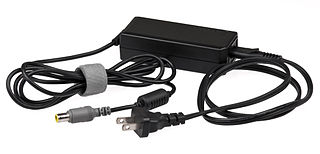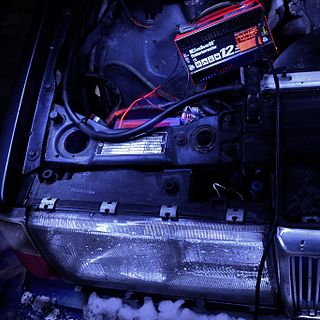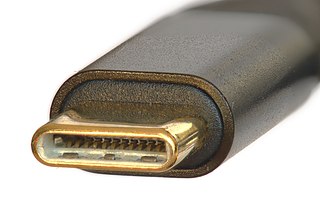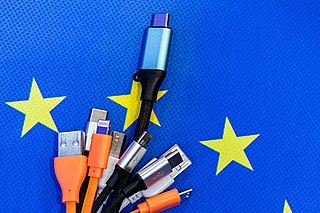
A DC connector is an electrical connector for supplying direct current (DC) power.

An AC adapter or AC/DC adapter is a type of external power supply, often enclosed in a case similar to an AC plug. Other common names include wall charger, power adapter, power brick, and wall wart. Adapters for battery-powered equipment may be described as chargers or rechargers. AC adapters are used with electrical devices that require power but do not contain internal components to derive the required voltage and power from mains power. The internal circuitry of an external power supply is very similar to the design that would be used for a built-in or internal supply.

The history of mobile phones covers mobile communication devices that connect wirelessly to the public switched telephone network.

The presence of the logo on commercial products indicates that the manufacturer or importer affirms the goods' conformity with European health, safety, and environmental protection standards. It is not a quality indicator or a certification mark. The CE marking is required for goods sold in the European Economic Area (EEA); goods sold elsewhere may also carry the mark.

A battery charger, recharger, or simply charger, is a device that stores energy in a battery by running an electric current through it. The charging protocol depends on the size and type of the battery being charged. Some battery types have high tolerance for overcharging and can be recharged by connection to a constant voltage source or a constant current source, depending on battery type. Simple chargers of this type must be manually disconnected at the end of the charge cycle. Other battery types use a timer to cut off when charging should be complete. Other battery types cannot withstand over-charging, becoming damaged, over heating or even exploding. The charger may have temperature or voltage sensing circuits and a microprocessor controller to safely adjust the charging current and voltage, determine the state of charge, and cut off at the end of charge. Chargers may elevate the output voltage proportionally with current to compensate for impedance in the wires.
The Open Mobile Terminal Platform (OMTP) was a forum created by mobile network operators to discuss standards with manufacturers of mobile phones and other mobile devices. During its lifetime, the OMTP included manufacturers such as Huawei, LG Electronics, Motorola, Nokia, Samsung and Sony Ericsson.

Intrinsic safety (IS) is a protection technique for safe operation of electrical equipment in hazardous areas by limiting the energy, electrical and thermal, available for ignition. In signal and control circuits that can operate with low currents and voltages, the intrinsic safety approach simplifies circuits and reduces installation cost over other protection methods. Areas with dangerous concentrations of flammable gases or dust are found in applications such as petrochemical refineries and mines. As a discipline, it is an application of inherent safety in instrumentation. High-power circuits such as electric motors or lighting cannot use intrinsic safety methods for protection.

A charging station, also known as a charge point or electric vehicle supply equipment (EVSE), is a power supply device that supplies electrical power for recharging plug-in electric vehicles.

Universal charger or common charger refers to various projects to standardize the connectors of power supplies, particularly for battery-powered devices.

CHAdeMO is a fast-charging system for battery electric vehicles, developed in 2010 by the CHAdeMO Association, formed by the Tokyo Electric Power Company and five major Japanese automakers. The name is an abbreviation of "CHArge de MOve" and is derived from the Japanese phrase "o CHA deMO ikaga desuka" (お茶でもいかがですか), translating to English as "How about a cup of tea?", referring to the time it would take to charge a car.
The Universal Power Adapter for Mobile Devices (UPAMD), codename IEEE 1823-2015, is an IEEE standard for power supply design intended to cater to the power range of 10–130 W for mobile devices like laptop computers. The power supply was required to have an output capacitive energy of less than 15.1 µJ and an inductive energy at disconnect of less than 5.3 µJ.

Conductive charging is conductive power transfer that replaces the conductive wires between the charger and the charged device with conductive contacts. Charging infrastructure in the form of a board or rail delivers the power to a charging device equipped with an appropriate receiver, or pickup. When the infrastructure recognizes a valid receiver it powers on, and power is transferred.
IEC Technical Specification 62700: DC Power supply for notebook computer is an IEC specification of a common standard for external laptop computer AC adapters. Laptops and AC adapters following this standard will have interchangeable power supplies, which will enable easy reuse of used power supplies and make buying a new compatible power supply for a laptop simpler.

USB-C, or USB Type-C, is a connector that supersedes previous USB connectors and can carry audio and/or video data, e.g. to drive multiple displays, or transfer data, e.g. to store a backup to an external drive, and providing/receiving power, such as to power a laptop or a mobile phone. It is applied not only by USB technology, but also by other protocols, including Thunderbolt, PCIe, HDMI, DisplayPort, and others. It is extensible to support future standards.

The Combined Charging System (CCS) is a standard for charging electric vehicles. It can use Combo 1 (CCS1) or Combo 2 (CCS2) connectors to provide power at up to 350 kilowatts (kW) . These two connectors are extensions of the IEC 62196 Type 1 and Type 2 connectors, with two additional direct current (DC) contacts to allow high-power DC fast charging. In response to demand for faster charging, 400 kW CCS chargers have been deployed by charging networks and 700 kW CCS chargers have been demonstrated.

The IEC 62196 Type 2 connector is used for charging electric vehicles, mainly within Europe, as it was declared standard by the EU. Based on widespread red IEC 60309 three phase plugs with five pins, which come in different diameters according to maximum current, a single size was selected, as maximum possible power will be communicated to the car via two additional communication pins and by a simple resistor coding within the cable. The onboard charger inside the car has to limit the current accordingly.
The Radio Equipment Directive established a regulatory framework for placing radio equipment on the market in the EU. All radio equipment within the scope of this directive that are placed on the EU market must have been compliant with the directive from 13 June 2017. The delay of the publication and approval of the details of this directive has led to difficulties for companies attempting to comply with the directive.
The initial versions of the USB standard specified connectors that were easy to use and that would have acceptable life spans; revisions of the standard added smaller connectors useful for compact portable devices. Higher-speed development of the USB standard gave rise to another family of connectors to permit additional data paths. All versions of USB specify cable properties; version 3.x cables include additional data paths. The USB standard included power supply to peripheral devices; modern versions of the standard extend the power delivery limits for battery charging and devices requiring up to 240 watts. USB has been selected as the standard charging format for many mobile phones, reducing the proliferation of proprietary chargers.

The IEC 62196 Type 3 connector is used for charging battery electric vehicles, mainly within France and Italy, as it was one of three AC plug standards described in IEC 62196-2. The Type 3 connector comes in two physical formats, Type 3A for single-phase (230V) and Type 3C for single- and three-phase (400V) alternating current (AC) power. Both have since been superseded by the Type 2 connector, the latter adopted as sole connector in 2013 by the European Union. The Type 1 connector is the corresponding AC connector standard used in North America, Japan, and South Korea.

The Directive (EU) 2022/2380 is a directive of the European Parliament and the European Council which was formally adopted on 23 November 2022 amending Radio Equipment Directive 2014/53. The directive mandates the use of USB-C as a universal charger using a standard USB-C to USB-C cable for smartphones, tablets, digital cameras, headphones, headsets, handheld video game consoles, portable speakers, e-readers, keyboards, mice, portable navigation systems, and earbuds that use wired charging by the end of 2024, and laptops by 2026. Furthermore, if said equipment is capable of being recharged by wired charging at voltages higher than 5 volts, currents higher than 3 amperes, or powers higher than 15 watts, the equipment must support the full functionality of USB Power Delivery.


















